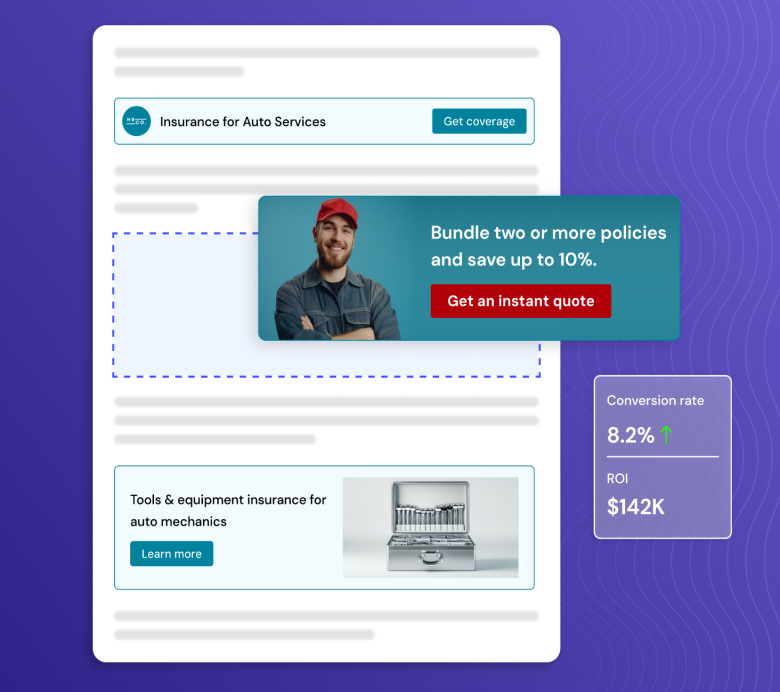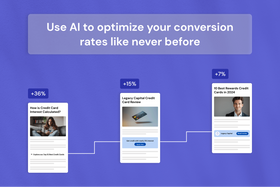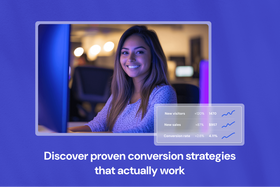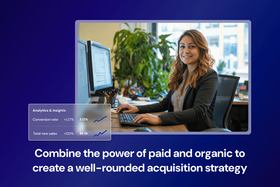How to increase customer lifetime value using CRO strategies
Explore actionable strategies to grow CLV and get more value from every customer.
Published April 16, 2025
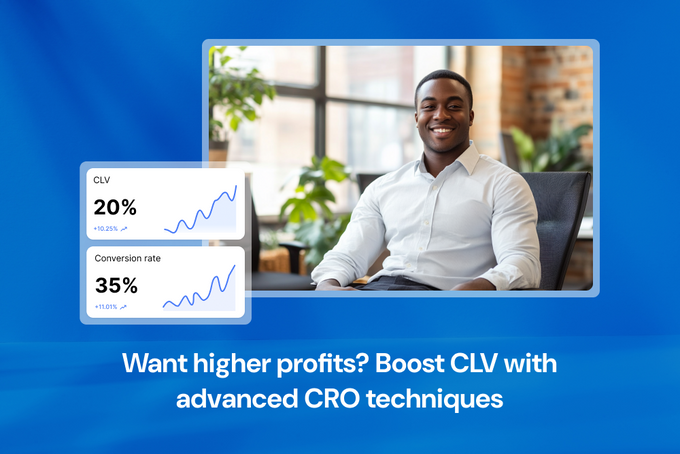
For many businesses, customer relationships are short-lived, leaving revenue stagnant and growth dependent on costly acquisition campaigns. Most companies focus obsessively on that first click but neglect the entire user journey. As a result, they miss out on opportunities to turn one-time buyers into loyal, high-value advocates.
Acquiring a new customer costs 5–25x more than retaining one. But if your checkout process is confusing, your post-purchase experience fizzles, or your messaging fails to resonate, even satisfied customers won't stick around.
The secret to boosting customer lifetime value (CLV) isn't spending more—it's optimizing smarter. With conversion rate optimization (CRO), you can transform even the most casual buyer into a brand advocate.
Key takeaways
- CLV estimates the total profit a customer will bring to a business over their entire relationship.
- Tracking CLV helps in making informed decisions about marketing, customer retention, and resource allocation.
- CRO helps increase CLV by creating experiences that encourage repeat business.
- An approach that uses customer behavior and feedback is essential for effective CRO strategies and better CLV.
What is customer lifetime value?
CLV is a business metric that estimates the total net profit a company can expect to earn from a customer throughout their lifetime relationship with the brand. It takes into account a customer's purchase frequency, average spend per transaction, retention rate, and the cost of serving them.
Understanding CLV guides strategic decisions for businesses, helping them optimize their marketing spend, prioritize the retention of high-value customers, and allocate resources effectively.
» Discover essential BOFU metrics to track for conversion.
Why it's important to increase CLV
There are several reasons why you need to increase CLV, including:
- Knowing CLV helps you decide where to put your energy and money, beyond just ads. It shows what products your best customers want and enables you to keep the right amount in stock.
- A good CLV makes your business look strong to investors. It means you're making money steadily, which can help you get funding and a better price if you ever sell.
- CLV can tell you which customers might leave, so you can try to keep them. You can also use it to offer special deals to your most valuable customers.
- Thinking about CLV makes your business focus on keeping customers happy for the long haul. These happy customers can also bring in new business by recommending you.
» Track the right marketing KPIs in 2026 and boost your content efforts.
How to calculate your CLV
To calculate your CLV, use this simple formula:
CLV = (Average purchase value × Purchase frequency × Gross margin) × Average customer lifespan
Average purchase value: Total revenue divided by the number of purchases in a period.
Purchase frequency: How often a customer buys from you annually (e.g., 4 times a year).
Gross margin: Profit percentage per sale (Revenue – Cost of goods sold).
Average customer lifespan: How long a customer stays with your business (e.g., 5 years).
Let's say a customer spends $50 per purchase, buys 4 times a year, stays for 5 years, and your gross margin is 20%.
Here's how you would calculate the CLV:
(50 × 4 × 0.20) × 5= $200
» Find out how optimizing your conversion funnel can help you boost revenue.
How CRO works to increase CLV
CRO directly impacts your CLV by creating frictionless, engaging experiences that encourage customers to return repeatedly.
It uses data-driven techniques like A/B testing, user feedback analysis, and behavioral analytics to find obstacles in the customer journey and fix them so your brand drives long-term loyalty.
Instead of focusing solely on immediate conversions, CRO helps you analyze the entire customer lifecycle, creating personalized experiences that emotionally connect your brand with the customer.
This systematic approach to improving customer interactions increases satisfaction, reduces churn, and extends the duration and value of customer relationships, significantly boosting CLV over time.
10 CRO strategies to boost CLV
1. Segment your customers and analyze their behavior
You should go beyond basic demographics and segment customers using behavioral data such as purchase frequency, recency, and average order value.
For example, an e-commerce brand might use RFM analysis (recency, frequency, monetary value) to find high-value customers who haven't purchased recently, then target them with personalized campaigns that will encourage them to purchase again.
You can integrate tools like GA4 or CRM platforms to track behavior and design tailored experiences for each segment. Avoid over-segmentation—focus on actionable groups where personalized efforts yield measurable ROI. Base your decisions on real-time data to prevent misalignment between offers and customer needs.
» Explore metrics and KPIs for each stage of the SEO funnel.
2. Personalize your onboarding and engagement funnels
Your onboarding processes should adapt to how each user behaves. A SaaS company, for example, could use in-app prompts to guide its users toward features relevant to their goals to reduce early churn.
You can implement this strategy by mapping user journeys, finding friction points, and deploying dynamic content triggered by specific actions. Don't overwhelm users with information—phase guidance based on their progress.
Pro tip: Avoid generic tutorials; instead, use real-time data to deliver contextually relevant support that evolves as your relationship with the customer matures.
» Learn how to create content that converts and boost your bottom line.
3. Optimize your upsells and cross-sells
Strategically recommend products by analyzing past customer purchases. For example, an online retailer noticing that customers who buy yoga mats often purchase water bottles could test bundled offers during checkout.
You can use A/B testing to refine your timing, placement, and messaging. For example, you can offer a complementary product post-purchase via email rather than interrupting the checkout flow. Take care to avoid aggressive or irrelevant suggestions. Instead, focus on value-driven suggestions that improve the customer's experience instead of those that are purely focused on revenue.
» Track the success of your marketing efforts with the right SEO KPIs.
4. Perform A/B and multivariate tests, focusing on retention
Prioritize CRO tests and experiments that directly influence long-term retention. For example, a subscription service might test different renewal reminder designs, discovering that adding social proof ("90% of users renew!") increases retention by 15%.
You should focus on metrics like repeat purchase rate and subscription length, not just initial conversions. Also, avoid testing minor elements (e.g., button colors) without clear hypotheses—target high-impact areas like pricing or loyalty program incentives.
5. Optimize customer experience beyond digital touchpoints
Your CRO strategies should extend to offline interactions. Let's say a furniture retailer finds that unclear assembly instructions lead to returns. They can redesign manuals to improve satisfaction and encourage repeat purchases.
Audit every touchpoint—packaging, delivery, post-purchase support—and use customer feedback to identify physical or service-related friction. Also, avoid siloing digital and physical teams. Collaborate across departments to ensure seamless experiences that build lasting loyalty.
» Find out why you need both SEO and CRO to maximize revenue.
6. Use unified customer data for advanced personalization
To deliver hyper-relevant experiences, you should merge data from email, browsing, and purchase history. For example, a beauty brand could use past purchases to suggest skincare routines via email and boost repeat orders.
You can implement a customer data platform to unite insights and automate personalized messaging. Avoid "uncanny valley" personalization—balance relevance with privacy by letting users control what they want to share. Also, avoid reusing stale data; refresh profiles continuously to stay accurate.
» Discover proven SEO lead generation techniques to convert visitors.
7. Strategically price and tier offers based on customer segments
Pricing should be tailored to willingness-to-pay. For example, a software company might offer a premium tier with advanced analytics for power users, found through usage data.
You can use surveys and purchase behavior to segment customers, then design tiered pricing with clear value differentiation.
Avoid sudden price hikes for loyal customers; instead, justify increases with improved features or exclusive perks. Don't assume one-size-fits-all pricing—test flexibility (e.g., annual vs. monthly plans) to cater to diverse budgets.
8. Build customer support and community across channels
Embedded support options like live chat, social media videos, and forums help brands interact with customers across channels. Train your support teams to use conversation history for personalized assistance, and reward community members who contribute solutions.
Also, avoid inconsistent responses across channels—centralize knowledge bases to maintain quality. Never treat support as a cost center; it's a loyalty-building opportunity.
» Learn to maximize revenue by boosting your conversions with AI.
9. Incorporate virtual and augmented reality experiences
Immersive previews can reduce purchase hesitation. Are you a furniture retailer? You can create software that visualizes products in customers' homes and reduces returns due to a lack of space.
You can start with products where fit or aesthetics matter and optimize the mobile AR software for accessibility. You should also avoid clunky interfaces and test load times and usability rigorously. Avoid forcing AR/VR on users; offer it as an optional tool alongside traditional product images and descriptions.
» Check out the best CRO tools to boost your conversions.
10. Continuously improve through a feedback-driven loop
The loop between feedback and action should be closed. For example, a meal-kit service analyzing delivery feedback might discover that late arrivals cause cancellations. An appropriate solution might be to optimize its logistics to cut customer churn.
To apply this strategy, you can automate feedback collection post-purchase and via email, then prioritize recurring issues. Avoid vague surveys—ask specific questions like "What nearly stopped you from buying?" to uncover hidden friction.
Pro tip: Make sure the feedback doesn't stagnate; communicate fixes to customers (e.g., "We heard you—here's how we improved") to reinforce trust and loyalty.
» Check out the most important conversion metrics to track in 2026.
Keep customers coming back for more
Implementing strategic CRO techniques, with a focus on building long-term customer relationships, can dramatically boost CLV. By optimizing each touchpoint throughout the customer journey, you can create experiences that foster loyalty and encourage ongoing relationships.
The most effective approach involves combining multiple CRO strategies and continuously testing and refining them based on customer data and behavior patterns.
